Ford Puma Review 2025
Ford Puma At A Glance
Insurance Groups are between 11–16
On average it achieves 0% of the official MPG figure
It may share its name with a sporty little coupe from the 1990s, but the Ford Puma is actually a small SUV that plays rival to the extrovert Nissan Juke, sensible Volkswagen T-Roc and pricey Honda HR-V. Like its namesake, it’s based on the Fiesta, yet it offers class-leading practicality, a fun driving experience and mild-hybrid engines. We’ll explain all in our Ford Puma review.
The Ford Puma is regularly one of Britain's best-selling cars and is available with Ford’s popular 1.0-litre three-cylinder EcoBoost petrol engine. Buyers can choose from two power outputs: 125PS or 155PS, both with mild-hybrid technology to improve fuel efficiency.
There's also a sporty ST version with a more powerful engine, or an all-electric version known as the Gen-E, but we've reviewed those separately.
While the more powerful of the two mainstream engines is a sportier offering and makes sense if you regularly drive at motorway speeds with several passengers, the standard 125 unit will be sufficient for most buyers. It’s a quiet and refined engine, although there is a little wind noise at higher speeds.
Unlike the lacklustre and thankfully-now-defunct Ford EcoSport, the Puma is as enjoyable to drive as we’ve come to expect from a Ford. It’s way ahead of the competition in the way it corners, with little in the way of body lean and excellent, communicative steering. It’s also good to drive around town, thanks to its impressive visibility and tight turning circle. The ride is a little firm compared with some rivals, but not uncomfortably so.
Things are good inside, too. There are lots of seemingly high-quality materials and a generous amount of standard equipment. The level of practicality in what is a small car (4186mm long, 1805mm wide and 1554mm high) is super-impressive, and the Puma is genuinely usable as a family car. Sure, adults might feel a tad cramped in the rear, there’s plenty of space for children, and the boot is massive, clever and well thought out.
There’s not much going against the Puma. Not everyone will appreciate its looks, and while it can look pricey alongside some rivals, you get what you pay for. It’s certainly no more expensive than the likes of the Volkswagen T-Roc and Peugeot 2008.
Ford Puma handling and engines
- Engines range from 1.0 EcoBoost 125 Automatic to 1.0 EcoBoost 170
- Readers report Real MPG to be between 41–55 mpg
Ford Puma 2025: Handling and ride quality
The first thing that strikes you about the Ford Puma is that it corners exceptionally well. It feels very much like the Fiesta, with little in the way of body lean, lots of grip, and a real eagerness to change direction. Even better, the steering is delightful, providing a huge amount of feedback.
Perhaps the best bit is that you don’t have to push the Puma hard to appreciate how good it is to drive. Even at low speeds, it’s easy to drive and feels eager to get around the place, so its agility adds to the fun around town.
There’s a little bit of wind noise at motorway speeds, but nothing more than you’d expect from a small SUV. Its ride is a little on the firm side compared to some rivals, too. It's not uncomfortable, but if you’re after outright comfort, you might be better with a Volkswagen T-Roc. ST-Line and ST-Line X trims come with a firmer sports suspension, and the latter with larger 18-inch alloy wheels, and these feel firmer still.
Selectable drive modes are standard across the range, giving you the ability to select between Normal, Eco, Sport, Slippery and Trail. These are pretty pointless, though: a manual gearbox and passive suspension means the only real giveaway that you’ve changed drive mode is a change in the display on the instrument cluster.

Ford Puma 2025: Engines
Ford makes a big deal out of the Puma being offered with mild hybrid engines. While the Puma isn’t a true hybrid car like the Toyota C-HR, it uses a belt-driven generator to recuperate energy normally lost during braking or coasting.
It can’t run under electric power alone, but it does bring a small fuel economy benefit. It also provides a minor boost in performance, particularly before the turbocharger kicks in, reducing the lag traditionally associated with turbocharged cars.
It also allows the engine to switch off as you come to a halt, although don’t expect to travel any meaningful distance with the engine off.
The Ford Puma is sold with a 1.0-litre three-cylinder turbocharged petrol engine available with 125PS or 155PS. The lower-powered unit was initially available with or without the mild hybrid system, but now both variants come exclusively as a mild hybrid.
The more powerful model is easy to recommend: it’s actually very fun to drive, with plentiful performance combined with a characterful three-cylinder soundtrack. It’ll cover 0 to 62mph in 9.0 seconds, quicker than most equivalent three-cylinder rivals, although it feels even more sprightly than that.
The 125PS model will be sufficient for most drivers, though. And no matter which engine you choose, the manual gear change is delightful, with a slick action and light clutch. If changing gear isn’t for you, there’s also a seven-speed automatic gearbox.
Ford Puma 2025: Safety
The Ford Puma scored a full five-star safety rating when tested by Euro NCAP in 2019. It achieved 94% for adult occupants, 84% for children, 77% for vulnerable road users and 74% for its safety assist systems.
Helping this score is the amount of safety tech that comes as standard. This includes a pre-collision assist system with autonomous emergency braking, while there’s also lane-departure warning and hill-start assist.
Opt for an early Puma ST-Line or ST-Line X and these come with rain-sensing wipers, while there’s also automatic headlights (with automatic high beam). These items were later made standard throughout the range.
The Megabox on the Puma means more storage, but the downside is that there's no space for a spare wheel, so you’ll have to rely on a tyre repair kit if you’re unfortunate enough to get a puncture. To be fair, however, that's usually the rule rather than the exception these days anyway.
Ford Puma 2025: Towing
The Ford Puma has a maximum towing weight of 1100kg braked. A detachable tow bar is available as an option.
| Engine | MPG | 0-62 | CO2 |
|---|---|---|---|
| 1.0 EcoBoost 125 | - | 9.8–10.2 s | 96–135 g/km |
| 1.0 EcoBoost 125 Automatic | - | 9.6–10.2 s | 128–141 g/km |
| 1.0 EcoBoost 155 | - | 8.9–9.0 s | 99–145 g/km |
| 1.0 EcoBoost 155 Automatic | - | 8.7 s | 128–129 g/km |
| 1.0 EcoBoost 170 | - | 7.4 s | 136–144 g/km |
Ford Puma interior
- Boot space is 456–1216 litres
- Euro NCAP rating of five stars
| Dimensions | |
|---|---|
| Length | 4186–4226 mm |
| Width | 1930 mm |
| Height | 1533–1537 mm |
| Wheelbase | 2588 mm |
Ford Puma 2025: Practicality
For a small SUV that majors on style and driving dynamics, the Ford Puma is very practical. The boot can take an impressive 456 litres of luggage – that’s more than the bigger Focus – and access is a useful metre wide. There’s a bit of a lip to hoist things over – not great if you regularly carry heavy items or need to transport a dog – but that’s a price you pay for choosing an SUV over an estate car.
Not only is there an adjustable boot floor, there’s also a very handy square luggage area underneath. Ford calls this the ‘MegaBox’. With its 80-litre capacity it can transport a surprising amount, while its hard-wearing plastic lining means it’s useful for carrying things like muddy boots or vegetables from the allotment. There’s even a drain plug so you can hose it out if required.
Ford’s also proud of its clever tailgate-mounted parcel shelf. This doesn’t get in the way when loading bulky items in the same way as a regular parcel shelf.
A combination of increased ground clearance and higher-mounted seats mean you’ll sit 60mm higher than you would've in a Fiesta, giving you a good view of the road ahead, a major reason why many people buy small SUVs like the Puma.
There’s a reasonable amount of space in the rear, although it is slightly claustrophobic, especially for children due to the rising window line.

Ford Puma 2025: Quality and finish
Up front, the Ford Puma’s cabin is very similar to the now-retired Fiesta’s. There are a few hard plastics here and there to remind you that you’re driving a Ford rather than something more premium (the handle for the glove box, for example). That said, it’s no worse than most rivals and pretty similar to something like a Volkswagen T-Roc.
Pick the Puma ST-Line X over the Titanium and ST-Line trims and you get some plusher part-leather seats and carbon-effect trim that lift the impression of quality in the cabin. That said, if you want a small SUV with a little bit of luxury, then something like an Audi Q2 will tick that box.
By and large the finish of the Ford Puma is good for the price.
Ford Puma 2025: Infotainment
Like most other Fords, the Puma features an infotainment screen perched on top of the dashboard. Its relatively high positioning makes it easy to glance at when you’re on the move.
In cars built up until late 2024, the screen was an 8.0-inch item, running Ford Sync3 infotainment system. It’s no surprise to find that this provides access to a suite of features, including navigation, DAB radio, Bluetooth, the Puma’s car set-up and connectivity to Apple CarPlay and Android Auto. There's also a wireless phone charge pad on pricier trim levels.
The graphics of this system look a little dated by modern standards, but the menus and controls are easily laid out, making it easy to navigate to the setting you want. It’s also more responsive than the systems in rivals like the Peugeot 2008 and DS 3 Crossback.
There’s also a 12.3-inch digital instrument display that’s standard on ST-Line, ST-Line X and Vignale models, with crisp, clear graphics. While not standard on Titanium models, it was offered as an option.
At this point in time, the Puma went against the trend of controlling the air conditioning via the touchscreen, with a dedicated set of buttons and dials on the centre console.
The Puma underwent a facelift in late 2024, a large part of which was the introduction of a new Sync4 infotainment system. The central screen became much larger at 12.0-inches, and a 12.8-inch digital driver display became standard across the range.
On the positive side, more functionality became available and the graphics looked a lot sharper, and the software works well and reacts quickly. On the not-so-positive side, those air-con physical controls - along with most other switchgear - were purged from the cabin, meaning the touchscreen needs to be used of even the most basic functions. This is not only more of a faff, but it's also more distracting when you're driving.
Ford Puma value for money
Ford Puma 2025: Prices
The Ford Puma is reasonably well priced, although cheaper alternatives are available. Pricing starts from around £27,000 for the 125PS 1.0-litre EcoBoost hybrid in Titanium trim.
If you want the more powerful 155PS EcoBoost hybrid you’re looking at a starting price of £31,690, partly because it's not available in the most basic trim levels. That's pretty much as high as prices for the regular models go, provided you're not consider the ST or Gen-E versions.
Ford is often a sucker for a special edition, and the Puma has been offered in plenty such forms over the years, with weird and wonderful names such as the 'ST-Line X Gold Edition' and the 'Vivid Ruby Edition'. These are often quite pricey, but do come with a disproportionately high amount of kit for the price you pay, so could be a high-value proposition if you fancy searching one out on the used car market.

Ford Puma 2025: Running Costs
The Ford Puma should be pretty cheap to run, with the 125PS 1.0-litre EcoBoost hybrid delivering up to 52.3mpg, and the slightly punchier 155PS version achieving 51.4mpg. If you find a used Puma with the standard 125PS (non-mild-hybrid) petrol engine, then expect 48.7mpg.
When it comes to insurance, it’s the non-hybrid 125PS petrol variant that's the cheapest Ford Puma to insure. Spec it in either Titanium or ST-Line trim and it falls into group 11. The current 125PS 1.0-litre EcoBoost hybrid though only pushes things up to insurance group 12 or 13, however.
Buy a Puma with the 155PS 1.0-litre EcoBoost hybrid engine, and its insurance group will be anywhere between 14 and 18, depending on trim level.
Satisfaction Index
 What is your car like to live with?
What is your car like to live with?
We need your help with our latest Satisfaction Index, so that we can help others make a smarter car buying decision. What's it like to live with your car? Love it? Loath it? We want to know. Let us know about your car - it will only take a few minutes and you could be helping thousands of others.
Help us with the Honest John Satisfaction Index nowFord Puma models and specs
For most of its life, the Puma has been offered with the same basic trim structure of Titanium, ST-Line, and ST-Line X. However, along the way, there have been other ST-Line-based trims - such as the ST-Line Vignale - and various special edition models that provide a heightened kit level for a comparatively low price.
What's more, the level of kit that each trim level gets as standard has risen incrementally over the years to keep the Puma appealing in the face of new competition. Our advice? If you want as much kit as you can get for your money on the used car market, buy the latest example you can afford.
Indeed, new car buyers currently choose from that same basic trim structure. The entry-level Ford Puma Titanium comes with a very decent slice of standard equipment, including:
- 17-inch alloy wheels
- LED projector headlights with LED daytime running lights
- Front foglights with cornering lights and LED rear lamps
- Rear privacy glass
- Climate control
- Quickclear heated windscreen
- Automatic headlights and wipers
- Rear parking sensors
- Reversing camera
- Cruise control
- Lane keeping aid and lane departure warning
- 12-inch touchscreen infotainment with navigation, Apple CarPlay and Android Auto
To that, the Ford Puma ST-Line adds:
- Power fooldiing door mirrors
- Sports suspension
- Redesigned cloth upholstery
- ST-Line bodykit
The Ford Puma ST-Line X tops the regular range, and features:
- 18-inch alloy wheels
- ST-Line X bodykit
- Premium B&O audio with four extra speakers
- Wireless phone charging
- Keyless entry and start
- Power tailgate
- Synthetic leather upholstery
| Dimensions | |
|---|---|
| Length | 4186–4226 mm |
| Width | 1930 mm |
| Height | 1533–1537 mm |
| Wheelbase | 2588 mm |
| Miscellaneous | |
|---|---|
| Kerb Weight | 1205–1358 kg |
| Boot Space | 456–1216 L |
| Warranty | 3 years / 60000 miles |
| Servicing | 10000 miles |
| Costs | |
|---|---|
| List Price | £26,085–£33,285 |
| Insurance Groups | 11–16 |
| Road Tax Bands | A–F |
| Official MPG | - |
| Euro NCAP Safety Ratings | |
|---|---|
| Adult | - |
| Child | - |
| Pedestrian | - |
| Overall | 5 |
Currently on sale
| SUV | |||
|---|---|---|---|
| Version | List Price | MPG | 0-62 |
| ST T EcoBoost 170 MHEV DCT Auto Start/Stop 5dr | £33,285 | - | - |
| ST-Line T EcoBoost 125 MHEV DCT Auto Start/Stop 5dr | £28,785 | - | - |
| ST-Line T EcoBoost 125 MHEV Start/Stop 5dr | - | - | - |
| ST-Line T EcoBoost 155 MHEV DCT Auto Start/Stop 5dr | £28,985 | - | - |
| ST-Line X T EcoBoost 125 MHEV DCT Auto Start/Stop 5dr | £29,235 | - | - |
| ST-Line X T EcoBoost 125 MHEV Start/Stop 5dr | - | - | - |
| ST-Line X T EcoBoost 155 MHEV DCT Auto Start/Stop 5dr | £30,535 | - | - |
| Titanium T EcoBoost 125 MHEV DCT Auto Start/Stop 5dr | £27,335 | - | - |
| Titanium T EcoBoost 125 MHEV Start/Stop 5dr | £26,085 | - | - |
| Titanium T EcoBoost 155 MHEV DCT Auto Start/Stop 5dr | £28,085 | - | - |
On sale until August 2024
On sale until February 2024
| SUV | |||
|---|---|---|---|
| Version | List Price | MPG | 0-62 |
| ST-Line Design 2 T EcoBoost 125 MHEV Start/Stop 5dr | - | - | 9.8 s |
On sale until April 2023
| SUV | |||
|---|---|---|---|
| Version | List Price | MPG | 0-62 |
| ST-Line X Gold Edition T EcoBoost 155 MHEV DCT Auto Start/Stop 5dr | - | - | 8.7 s |
| ST-Line X Gold Edition T EcoBoost 155 MHEV Start/Stop 5dr | - | - | 8.9 s |
On sale until December 2022
| SUV | |||
|---|---|---|---|
| Version | List Price | MPG | 0-62 |
| ST-Line X T EcoBoost 125 DCT Auto Start/Stop 5dr | - | - | 10.2 s |
| ST-Line X T EcoBoost 125 MHEV Start/Stop 5dr | £25,240 | - | 9.8 s |
| ST-Line X T EcoBoost 155 MHEV Start/Stop 5dr | £25,970 | - | 8.9 s |
On sale until September 2022
| SUV | |||
|---|---|---|---|
| Version | List Price | MPG | 0-62 |
| ST-Line Design T EcoBoost 125 MHEV DCT Auto Start/Stop 5dr | £25,275 | - | 10.2 s |
| ST-Line Design T EcoBoost 125 MHEV Start/Stop 5dr | £23,435 | - | 10.2 s |
| ST-Line Design T EcoBoost 155 MHEV Start/Stop 5dr | £24,185 | - | 9.0 s |
| Titanium Design T EcoBoost 125 MHEV DCT Auto Start/Stop 5dr | £23,635 | - | 10.2 s |
| Titanium Design T EcoBoost 125 MHEV Start/Stop 5dr | £21,835 | - | 10.2 s |
| Titanium Design T EcoBoost 155 MHEV Start/Stop 5dr | £22,585 | - | 9.0 s |
On sale until July 2021
| SUV | |||
|---|---|---|---|
| Version | List Price | MPG | 0-62 |
| ST-Line T EcoBoost 125 DCT Auto Start/Stop 5dr | - | - | 10.2 s |
| ST-Line X T EcoBoost 125 DCT Auto Start/Stop 5dr | - | - | 10.2 s |
| Titanium T EcoBoost 125 DCT Auto Start/Stop 5dr | - | - | 10.2 s |
On sale until October 2020
| SUV | |||
|---|---|---|---|
| Version | List Price | MPG | 0-62 |
| 1.0 EcoBoost 125 St-Line 5dr | £24,190 | - | 9.8 s |
On sale until August 2020
| SUV | |||
|---|---|---|---|
| Version | List Price | MPG | 0-62 |
| 1.0 EcoBoost 125 Titanium 5dr | £23,240 | - | 9.8 s |
| 1.0 EcoBoost Hybrid mHEV 125 ST-Line X First Edition 5dr | £25,195 | - | 9.8 s |
| 1.0 EcoBoost Hybrid mHEV 125 Titanium First Edition 5dr | £22,295 | - | 9.8 s |
| 1.0 EcoBoost Hybrid mHEV 155 ST-Line X First Edition 5dr | £25,945 | - | 9.0 s |
| 1.0 EcoBoost Hybrid mHEV ST-Line X First Edition Plus 5dr | £27,345 | - | 9.0 s |
Model History
- April 2019: Ford teases Puma crossover SUV
- October 2019: Ford Puma priced from £20,845
- June 2020: Automatic gearbox and ST-Line Vignale X model added to Puma line-up
- June 2020: Seven-speed auto added to 125PS 1.0-litre EcoBoost.
- February 2024: Revised Ford Puma now on sale, priced from £25,790
April 2019
Ford teases Puma crossover SUV
The new Ford Puma will be a small crossover SUV to take on the Nissan Juke, Mazda CX-3 and SEAT Arona.
Sharing a platform with the Fiesta, Ford has suggested its new Puma will be extremely practical, with a best-in-class boot capacity of 456 litres.
It's also set to feature 48-volt mild-hybrid technology, which will work with the firm's three-cylinder 1.0-litre EcoBoost petrol engine. This is likely to be available with a variety of power outputs, with the top engine producing 155PS.
The Puma will go on sale at the end of 2019, with prices expected to start at around £21,000 - positioning it between the EcoSport and Kuga in Ford's range.
October 2019
Ford Puma priced from £20,845
Ford has announced UK pricing for its new Puma crossover.
The Ford Puma Titanium, available from £20,845, features segment-first driver and passenger lumbar massage seats as standard, in addition to advanced wireless charging. The Ford Puma Titanium First Edition, available from £22,295, features comfort and safety technology packs including Intelligent Adaptive Cruise Control, Rear View Camera, Heated Seats and Heated Steering Wheel. Available with 1.0l EcoBoost Hybrid 125PS mHEV, the Puma Titanium also features exclusive exterior and interior details.
Puma First Editions are also available in ST-Line X trims, adding sporty interior and exterior design cues and sports suspension, alloy pedals, full digital instrument cluster and LED headlamps. Starting from £25,195, ST-Line X First Edition includes Handsfree Power Tailgate, 18-inch alloy wheels and 10-speaker B&O Premium Audio, available with 1.0-litre EcoBoost Hybrid 125PS or 155PS mHEV.
Puma ST-Line X First Edition Plus is available to order from £27,345 with 1.0-litre EcoBoost Hybrid 155PS, adding Panorama Roof and 19-inch alloy wheels.
June 2020
Automatic gearbox and ST-Line Vignale X model added to Puma line-up
A new seven-speed automatic transmission option for the 125PS 1.0-litre EcoBoost engine delivers from 138g/km CO2 and 45.6mpg WLTP. Priced from £22,945.
Based on the sporty Puma ST-Line X variant, the Puma ST-Line X Vignale available from £25,240, adds exclusive 18-inch alloys, a satin aluminium upper grille and surround, ebony lower grille, and body-coloured lower rear bumper. Standard specification includes signature LED headlights, Windsor leather seats, wrapped instrument cluster, heated front seats, heated steering wheel and Ford KeyFree system.
June 2020
Seven-speed auto added to 125PS 1.0-litre EcoBoost.
New option delivers from 138g/km and 45.6mpg.
Customers can now for the first time choose from Puma models equipped with a new seven-speed dual-clutch automatic transmission, and a luxurious new Puma ST-Line X Vignale variant.
Puma customers were from late last year among the first to benefit from Ford’s 48-volt mild hybrid technology for enhanced petrol fuel efficiency. Puma EcoBoost Hybrid powertrains are offered with two power outputs in combination with six-speed manual transmissions:
- 125 PS 1.0-litre EcoBoost Hybrid delivering from 127 g/km and 49.6 mpg WLTP)
- 155 PS 1.0-litre EcoBoost Hybrid delivering from 127 g/km and 49.6 mpg WLTP)
The six-speed manual 125 PS 1.0-litre EcoBoost delivers from 132 g/km and 47.9 mpg WLTP.
February 2024
Revised Ford Puma now on sale, priced from £25,790
Ford has shared details of its upgraded Puma, which features a host of revised technology to maintain its popularity as one of the UK's top-selling cars.
Priced from £25,790, exterior changes to the new Puma are limited to the option of new Dynamic Matrix LED headlamps.
However, bigger changes have happened inside, with new models getting 5G connections, Ford's SYNC4 infotainment that's twice as powerful as the previous generation system and a 0.5-inch larger 12.8-inch digital instrument cluster.
The updated Puma also benefits from improved adaptive cruise control, a 360-degree camera system and other driver aids. Although the engine range is unchanged, Ford has also confirmed an all-electric Puma Gen-E will be revealed later in 2024.


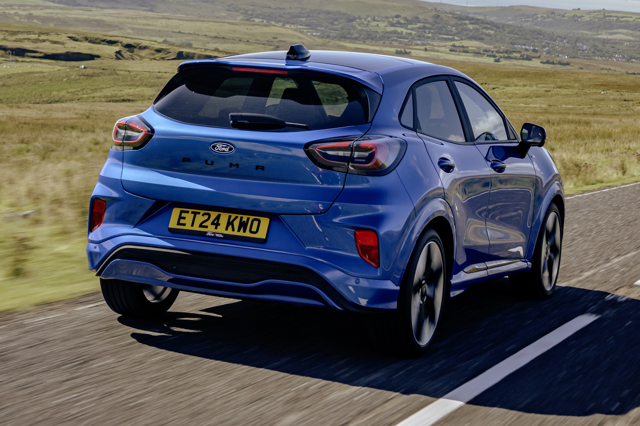
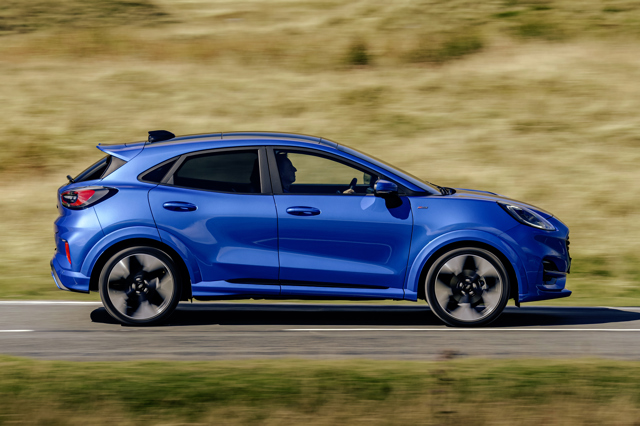
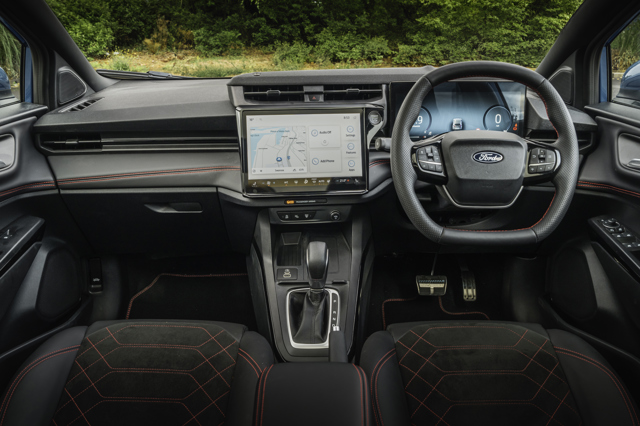
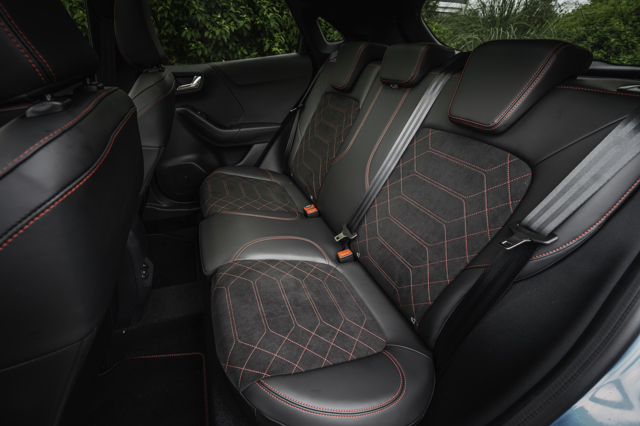
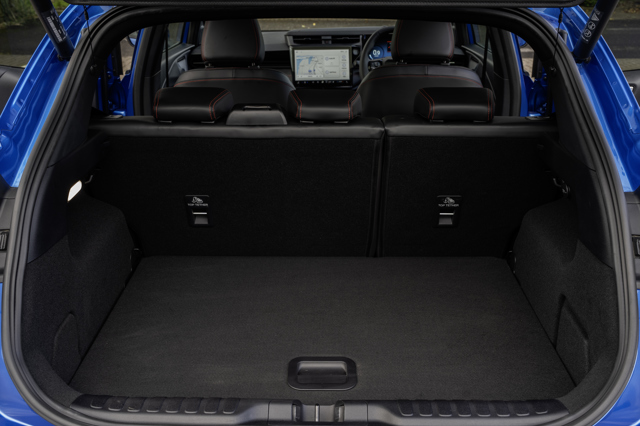
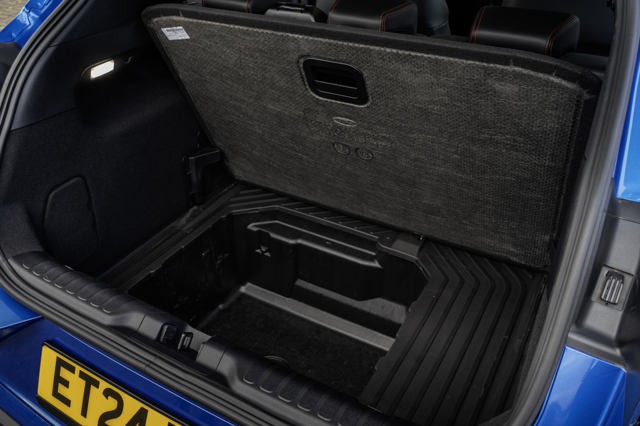
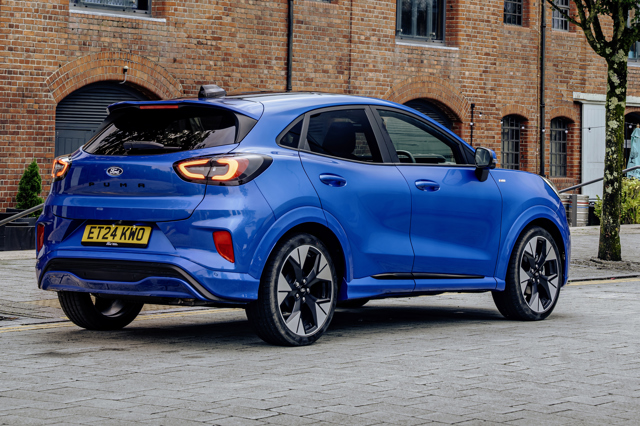
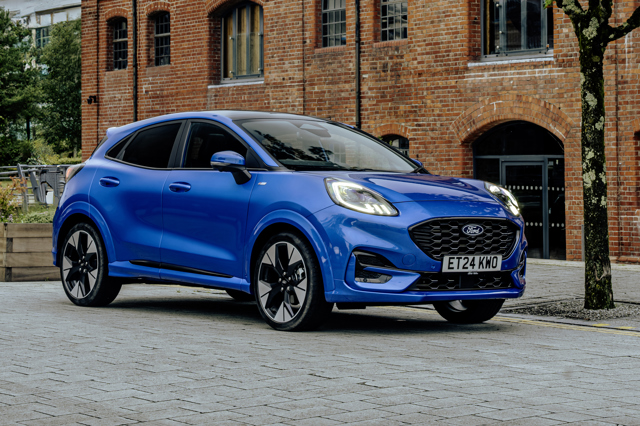
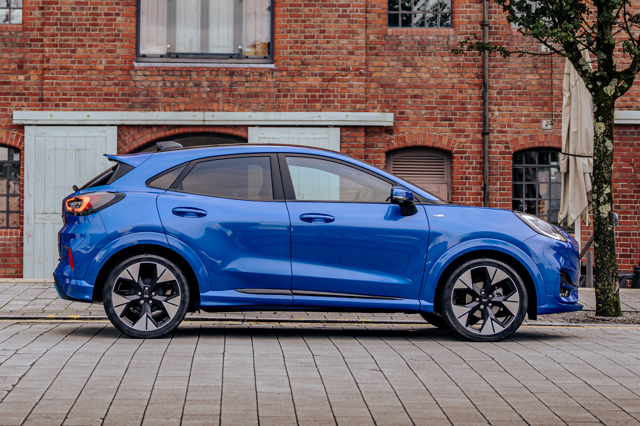


 Excellent to drive. Generous amount of standard equipment. Huge boot.
Excellent to drive. Generous amount of standard equipment. Huge boot.
 Slightly claustrophobic rear seats. 18-inch wheels generate lots of road noise.
Slightly claustrophobic rear seats. 18-inch wheels generate lots of road noise.





